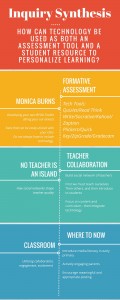How can technology be used as both an assessment tool and a student resource to personalize learning?
Where I came from: I knew that I wanted to incorporate technology into my practice, I wanted to use technology to both enhance my teaching as well as use it as an assessment tool. I was eager to see how technology was being utilized in todays classrooms. My practicum classroom has access to a number of technology resources with in the classroom and wider school community, including: iPads, laptops, iMacs, and a number of tech tools. I noticed that technology was being used as both an assessment tool as well as a tool for facilitating brain breaks. I was interested in how to facilitate technology for both my assessment as well as student learning.
Where am I now: I am working to integrate technology into both my unit and lesson plans. Yet, I am being mindful to focus on both the content and curriculum and then taking the opportunity to integrate technology. Fabrikant et al suggest that it is important for us to know what we are doing before we expect our students to know. We should familiarize ourselves with the information and the use of technology before we require our students to use it within the classroom. Using technology is not about having another teacher in the classroom, but using it to enhance our lessons and better equip students. I have also been influenced by Monica Burns writing, which is featured on Edutopia. With the help of Vicki Davis, also featured on Edutopia, I have begun to develop my own ‘toolkit’ of technology resources. Developing a ‘toolkit’ is a personal process; it is a set of tools which are personalized to the needs of both your class and yourself. The article ‘No Teacher is an Island: How Social Networks Shape Teacher Quality’ opened my eyes to the importance of establishing a strong social network, working with other teachers and professionals. The importance of these networks is to learn from one another; to learn from and teach others the tools that I have been able to utilize within my classroom and they have been working with. It also strengths our ability to use these tools as we are teaching and learning from other professionals before attempting to use them within our own classrooms or with our own students.
Where am I headed: Throughout my inquiry I have come to recognize and appreciate the need for media literacy. As our world progresses we constantly have access to technology and the various facets of technology – yet, many students do not yet have the skills to utilize this technology or become an active participant in a social network. I would like to continue to research ideas on how to effectively introduce students to media literacy, as well as what it means to be an active member of social networks. I would like to work not only with students, but also with parents to establish their presence on the class Freshgrade account. As we are utilizing Freshgrade as an assessment tool, it is important that both parents and student know how to make meaningful and constructive comments on displays of student work.
Works Cited
Baker-Doyle, K. (2015). No teacher is an island: how social networks shape teacher quality. Promoting and Sustaining a Quality Teacher Workforce, 367-383. Retrieved from: https://www.academia.edu/19709903/No_Teacher_is_an_Island_How_Social_Networks_Shape_Teacher_Quality
Burns, Monica (2015). Empowering teachers with tech-friendly formative assessment tools. Retrieved from: http://www.edutopia.org/blog/tech-friendly-formative-assessment-tools-monica-burns
Davis, Vicki (2014). The epic BYOD toolchest (51 tools you can use now). Retrieved from: http://www.edutopia.org/blog/the-epic-byod-toolchest-vicki-davis
Fabrikant, K., York, S., Morris, M. Integrating technology into pedagogical content knowledge in K-12 and university professional development. Building Sustainable Futures for Adult Learners, 541-558. Retrieved from: https://www.academia.edu/21070374/Integrating_technology_into_pedagogical_content_knowledge_in_K-12_and_university_professional_development

 be used as both an assessment tool and a student resource to personalize learning?eva walsh
be used as both an assessment tool and a student resource to personalize learning?eva walsh